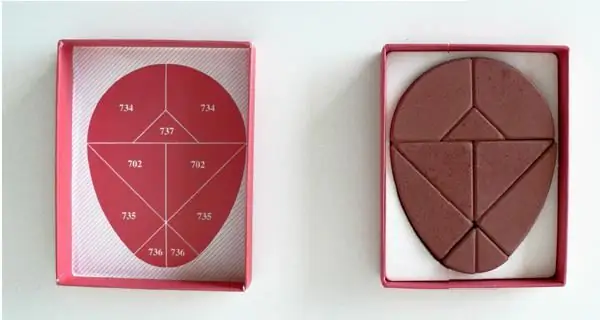
Inhaltsverzeichnis:
- Autor Sierra Becker [email protected].
- Public 2024-02-26 04:44.
- Zuletzt bearbeitet 2025-01-22 22:11.
Im Gegensatz zu einem Würfel können Sie mit Rubiks Schlangenpuzzle jedes Mal eine neue Figur erstellen. Nur wenige wissen es, aber es gibt bereits mehr als hundert von ihnen. Und ständig tauchen neue Schemata auf, welche Schlangenformen tatsächlich erstellt werden können.
Ein Standardpuzzle hat 24 Teile. Es gibt aber auch längere Varianten, zum Beispiel mit 36 oder 48 Teilen.
Modelle, die daraus erstellt werden, werden in zweidimensionale und dreidimensionale unterteilt. Einige von ihnen sind ziemlich einfach, besonders aus der ersten Gruppe. Auch jüngere Schüler können damit umgehen. Aber es gibt Zahlen, über die sich selbst ein im Zusammenbau erfahrener Mensch den Kopf zerbricht.
Interessanterweise kann es im allgemeinen Sinn nicht als Puzzle bezeichnet werden. Denn es ist eher ein Konstrukteur, der nach einem vorgeplanten Plan zusammengebaut werden muss. Oder lassen Sie sich etwas Besonderes einfallen. Und dann anderen beibringen.
Dieses Rubik-Puzzle hilft, räumliches Vorstellungsvermögen und Kreativität zu entwickeln. Es wird sich als unbestreitbarer Helfer bei der Bildung der Logik desjenigen erweisen, der es sammelt.

Wie liest man Figurenaufbaudiagramme?
Zunächst musst du die Schlange richtig positionieren. SieDie Ausgangsposition ist wie folgt: Alle Teile bilden eine gerade Linie. Wenn Sie es von der Seite betrachten, dann sind die dunklen Dreiecke unten. Dementsprechend sind die hellen oben.
Alle dunklen Dreiecke sind von 1 bis 12 nummeriert. Natürlich von links nach rechts. Diese dunklen Teile im Prozess des Zusammenbaus der Figur aus der Schlange bleiben bewegungslos. Leichte Teile drehen sich. Der nächste Absatz der Anleitung zum Zusammenbau einer Figur aus einer Schlange beginnt mit dieser Nummer.
Wenn Sie das linke Dreieck drehen müssen, enthält die Anweisung den Buchstaben "L". Der rechte Teil dreht sich, wenn der Buchstabe „P“vorhanden ist.
Die Anzahl der Umdrehungen ist auf 3 begrenzt. Da die vierte das Teil in seine ursprüngliche Position zurückbringt. Die Anzahl der Umdrehungen kommt nach dem Buchstaben, der links oder rechts angibt. Die Bewegung erfolgt im Uhrzeigersinn.
Daher besteht jeder Teil der Anleitung zum Zusammenbau einer Zauberschlangenfigur aus drei Komponenten:
- Dreieckszahl (1-12);
- Schwenkseite (L oder R);
- Anzahl der Umdrehungen (1-3).
Zum Beispiel 10L1. Sie sagt, man solle das helle Dreieck einmal links neben dem dunklen drehen.
Wenn man sich an diese Regel erinnert, ist es einfach, jede Figur zusammenzubauen. Und schreiben Sie sogar Ihren eigenen Algorithmus, wenn Ihnen etwas Besonderes einfällt. Und es wird jedem klar sein. Damit die Montagetechnik für Ausländer verständlich ist, ist es üblich, die russischen Buchstaben L und P durch das lateinische L und R zu ersetzen.
Die Figur namens "Bogen"
Dieses Spiel ist ein Schlangenpuzzle. Figuren haben manchmal einen Namen, dessen Herkunft nicht ganz klar ist. Das gleiche mit diesem. Für viele ähnelt es eher einer Blume. Der Assemblierungsalgorithmus besteht aus den folgenden Aktionen:
1P3; 2L1; 2P3; 3L3; 4P1; 4L3; 3P3; 5L3; 5P3; 6L1; 6P3; 9L3; 8P1; 8L3; 7P3; 7L3; 9P3; 10L1; 12P1; 12L3; 11P3; 11L3; 10P3.

Entschlüsselungsanweisungen:
- dreimal rechts von den ersten Kurven;
- links vom 2. - 1 Mal;
- von rechts - 3;
- rechts vom 3. - 3 mal;
- 1 Rechtskurve von der 4.;
- von links - 3;
- zurück zur dritten und rechts abbiegen zur 3;
- um die fünfte, zuerst um 3 nach links und dann um 3 nach rechts;
- ab der sechsten Drehung - links auf 1, rechts auf 3;
- in der Nähe des neunten linken Dreiecks dreimal drehen;
- ungefähr achte Rechtskurve 1 Mal und Linkskurve 3 Mal;
- von der Septim symmetrisch nach links und rechts um 3;
- der zehnte von links hat eine Umdrehung;
- in der Nähe des zwölften dreht sich der rechte 1 Mal und der linke 3 Mal;
- ab dem elften wieder Symmetrie links und rechts in 3 Umdrehungen;
- die rechte Seite vom 10. macht 3 Umdrehungen.
Es wird keine weitere Erklärung wie diese geben.
Anleitung für Giraffenfigur
Noch ein 3D-Modell. Diesmal tierisch. Wie die vorherige Abbildung kann es aus allen Blickwinkeln betrachtet werden. Algorithmus zum Zusammenbau des Modells:
2P1; 3L3; 3P1; 4P3; 5L3; 4L2; 6L3; 6P3; 8P1; 8L3; 7P1; 7L2; 12P2.
Wie macht man aus einer Schlange ein kompaktes Dreieck?
Die Zeit ist reif für Figuren, die unbelebte Objekte darstellen. Ein Beispiel ist volumetrischdreieckiges Prisma. Um es zu erstellen, ist die folgende Anweisung hilfreich:
1P3; 3L2; 4P3; 3P2; 5P1; 5L2; 6P3; 7L2; 7P3; 6L2; 8P1; 8L2; 9P3; 11L2; 12P1; 9L2.
Wie macht man einen Ball?
Dies ist die berühmteste Figur aus diesem Puzzle. Der Algorithmus für seine Erstellung lautet wie folgt:
1P1; 2L3; 2P3; 3L1; 3P1; 4L1; 4P1; 5L3; 5P3; 12P3; 12L3; 11P3; 11L3; 10P1; 10L1; 9P1; 9L1; 8P3; 8L3; 7P1; 6P3; 6L3; 7L1.
Eine von vielen Gurtoptionen
Es gibt eine große Anzahl aller Arten von Webereien. Dieses Beispiel ähnelt stark einem dicken Zopf. Um es zu weben, müssen Sie die folgende Abfolge von Drehungen ausführen:
1P3; 2L1; 2P3; 3L1; 3P3; 4L1; 4P3; 5L1; 5P3; 6L1; 7L1; 7P1; 8L3; 8P1; 9L3; 9P1; 10L3; 10P1; 11L3; 11P1; 12L3; 12P3; 6P1.
Entenfigur
Die meisten Gegenstände, die aus einem Puzzle hergestellt werden können, sind Tiere und Vögel oder Fahrzeuge. Dies ist ein Beispiel für eine Schlangenfigur, die einer Ente ähnelt. Ihr Algorithmus:

1P2; 3P1; 4P1; 6L1; 8P1; 7L3; 6P2; 9P3; 9L2; 11L3; 12L3.
Wie baue ich die Straußenfigur zusammen?
Noch ein Vogel, für dessen Erschaffung eine Schlange (Formen) benötigt wird. Montageanleitung:
1P2; 3L1; 2P2; 3P3; 4L1; 4P1; 5L1; 6L3; 5P1; 6P3; 7L3; 8L1; 7P3; 8P1; 9L2; 10L2; 12P2.
Es kann sogar von allen Seiten platziert und betrachtet werden. Echtes 3D-Modell.

Model für Romantiker "Herz"
Erlaubt Ihnen, Ihre Gefühle ohne Worte auszudrücken. Warum nicht einen Valentinstag für einen TagLiebhaber? Und der Algorithmus ist ganz einfach, zumindest kurz:
7L2; 9P1; 4P3; 3P3; 10P1; 12L2; 2L2.
Als Fazit
Nachdem Sie mehrere Figuren nach einem durchdachten Algorithmus erstellt haben, möchten Sie sicherlich etwas Eigenes erstellen. Vielleicht wurde es schon von jemandem erfunden. Aber für jemanden, der sich das schon einmal gedacht hat, wird das Modell eine echte Entdeckung sein. Und was kann ein großer Anreiz für die Entwicklung sein?
Empfohlen:
Fang an zu häkeln. Ist es besser für ein Mädchen, ein Oberteil oder ein Sommerkleid zu wählen?

Anfängerinnen sind bei der Auswahl des ersten Modells oft verwirrt: Was soll man wählen? Versuchen Sie, ein Sommerkleid für ein Mädchen zu häkeln oder zu stricken
"Kolumbus-Ei" ist ein spannendes Puzzle für Kinder und Erwachsene

"Kolumbus-Ei" ist ein Spiel, das bei Kindern jeden Alters räumliches Vorstellungsvermögen und Einfallsreichtum, phantasievolles Denken und Logik, Ausdauer und kreative Fähigkeiten entwickeln kann
Puzzle ist ein kreatives und intellektuelles Hobby

Puzzle ist ein über zweihundert Jahre altes Spiel. Während seiner Existenz hat sich das Puzzle aus Holzteilen zu modernen Geräten entwickelt und ist nicht nur zu einem Lieblingsspiel für Kinder, sondern auch zu einem Hobby für Erwachsene geworden
Ein Ballonaffe ist ein lustiges Spielzeug für ein Kind

Begeisterte Menschen sind in der Lage, aus improvisierten Materialien, die in verschiedenen Techniken arbeiten, wahre Wunder zu vollbringen. In letzter Zeit gibt es immer mehr solcher Bereiche der Kunst. Manchmal nehmen gewöhnliche Dinge, die in den Händen solcher Zauberer waren, ein neues Leben an. Das passiert mit gewöhnlichen Luftballons. Sie machen sogar Spielzeug daraus. Einer von ihnen ist ein Ballonaffe
Ein wunderbares Geschenk für einen lieben Menschen - ein Schal für Männer. Stricknadeln lernen, ein warmes Accessoire zu stricken

Möchten Sie Ihren Liebsten ein originelles Geschenk machen? Stricken Sie ihm einen Schal mit Herrenstricknadeln. Es ist nicht nur warm, sondern auch sehr modisch. Sogar ein Strickanfänger kann ein solches Produkt mit eigenen Händen herstellen. Wenn Sie die Namen der Maschen kennen und eine Vorstellung von deren Umsetzung haben, dann können Sie problemlos einen Herrenschal mit Stricknadeln stricken. Verwenden Sie die Vorschläge in diesem Artikel als Tipps
